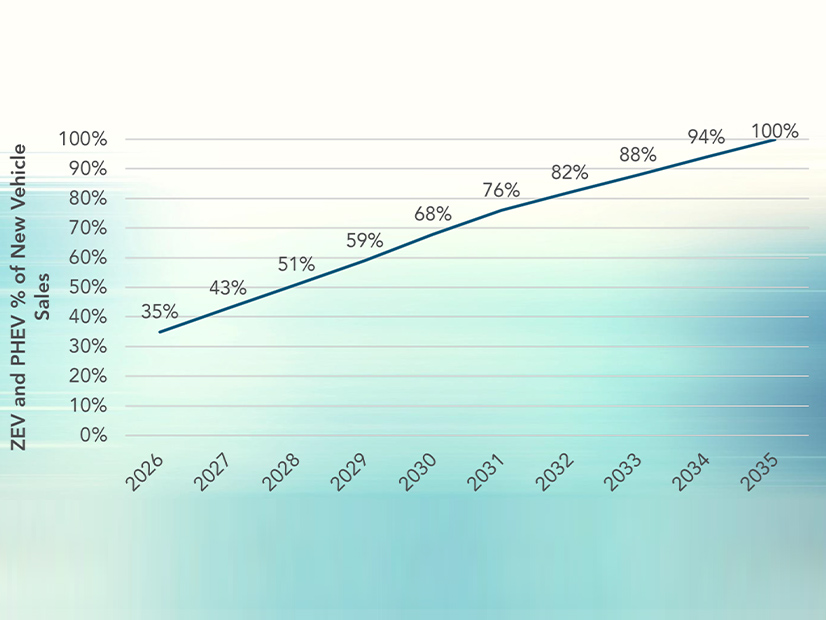
The California Air Resources Board on Thursday adopted regulations that will require all new cars sold in the state to be zero-emission or plug-in hybrid by 2035 — a move the agency described as historic and trailblazing.
The CARB board voted unanimously to approve the regulations, called Advanced Clean Cars II (ACC II).
“This is the most important and most transformative action that CARB has ever taken,” board member Daniel Sperling said. Sperling, who is a founding director of the Institute of Transportation Studies at the University of California, Davis, cast his vote by saying “super aye.”
“We can solve this climate crisis if we focus on the big, bold steps necessary to cut pollution. California now has a groundbreaking, world-leading plan to achieve 100 percent zero-emission vehicle sales by 2035,” Gov. Gavin Newsom said in a statement.
ACC II will require car manufacturers to provide for sale in California an increasing percentage of zero-emission vehicles each year. The new regulation starts with a 35% zero-emission vehicle (ZEV) sales requirement for model year 2026, increasing to 68% in 2030 and reaching 100% in 2035.
The rules build on the state’s Advanced Clean Cars regulation, which was first adopted in 2012 and is still in effect. The current regulation’s ZEV sales requirement tops off at 22% for model year 2025.
In addition to ZEV requirements, the ACC II regulation includes a low-emission vehicle (LEV) component aimed at reducing tailpipe emissions of gasoline-powered cars.
Seventeen states have adopted California’s Advanced Clean Car standards as allowed under Section 177 of the Clean Air Act. Many of those states are now expected to consider adoption of ACC II.
CARB must apply for and receive a waiver from the EPA to enforce the regulations.
Reducing GHG
Transportation is California’s single largest source of greenhouse gas emissions and air pollution, according to CARB. ACC II is expected to reduce passenger vehicle GHG emissions by 50% or more by 2040.
Environmental groups commended CARB for adopting ACC II.
“The standards passed today move California to the head of the pack in the race for clean transportation,” Fred Krupp, president of Environmental Defense Fund, said in a statement. “Thanks to the state’s leadership, California — and our entire country — are now speeding toward a safer and healthier future with no tailpipe pollution.”
But some people who commented during the board meeting were concerned about the impact of the ZEV requirements on small businesses and farmers. One farmer asked CARB staff how she is supposed to install a Tesla charging station in the middle of her cornfield.
ACC II applies to new vehicle sales and will not impact vehicles already on the road.
One speaker at the board meeting predicted that as a result of the regulation, drivers will hang on to their internal-combustion engine vehicles longer, bringing in more business for mechanics.
Infrastructure Is Key
CARB board member Barbara Riordan cautioned that building sufficient EV charging infrastructure will be key to the success of the program.
While substantial funding has been earmarked for EV infrastructure, “it has to be implemented,” Riordan said.
“A lot of people won’t invest in an electric vehicle unless they can be assured that the infrastructure is there to keep it charged, to keep it going,” she said.
The ZEV sales requirements of ACC II apply to cars, pickup trucks and SUVs. Plug-in hybrid (PHEVs), full battery-electric and hydrogen fuel cell vehicles count toward an automaker’s requirement. PHEVs must have an all-electric range of at least 50 miles under real-world driving conditions. Automakers will be able to meet up to 20% of their ZEV requirement with PHEVs.
Battery-electric and fuel cell vehicles will need a minimum range of 150 miles to qualify under the program. In addition, they must include fast-charging ability, come with a charging cord and meet new warranty and durability requirements.



